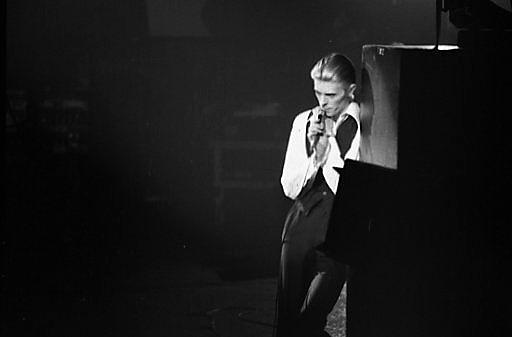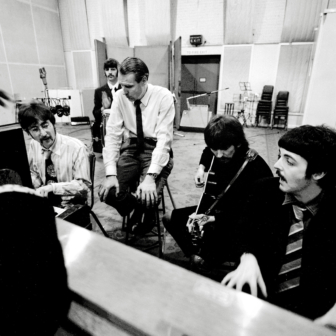Anyone who was fortunate enough to see the exhibition David Bowie Is at the Australian Centre for the Moving Image in Melbourne last year must now be feeling a sense of irony about its title. The exhibition, a stunning retrospective of Bowie’s career, continues on its travels, but will it be the same as the story of what David Bowie was?
It is almost impossible to imagine Bowie as a posthumous figure. He was (do we really have to use that tense?) a time traveller who went through more reincarnations than the Doctor. There was Ziggy Stardust, born with the 1972 album bearing his name, followed by the more austere alien of Nicolas Roeg’s 1976 film The Man Who Fell to Earth. Then came the Thin White Duke of his so-called Berlin period (1976–79), the Goblin King of Jim Henson’s Labyrinth (1986), and his uncanny impersonation of Nikola Tesla in The Prestige (2006). The neoclassical Bowie of A Reality Tour (2010) seemed like a return to earth, but it seems we couldn’t keep him long.
Yet he made his presence felt, right up to the last minute. The outpouring of obituaries came hard on the heels of the critical accolades that greeted his final album, Blackstar, released on 9 January. An accompanying video work, “Lazarus,” shows that, even on his deathbed, Bowie was in his prime. He was always in his prime. His genius was to take media images that were somehow familiar and twist them, then twist them again, ratcheting up the strangeness until you really could believe he was a being from another planet.
Or a figure from the 1973 Rocky Horror Show, escaped from the confines of the stage to turn the entire planet into the arena for a costume drama. Bowie’s mansion in Beckenham at that time may well have been a model for the Rocky Horror set. There was an ornate staircase, a minstrels’ gallery, and a giant Regency bed that Bowie decked out like a huge coffin with a canopy.
His trademark androgyny and cross-dressing bravura were signals of other forms of crossing. In his self-managed development as an independent performer, he alternately wanted hatred and adoration from the crowds in the auditorium. While there was much generic raving in Ziggy Stardust’s reception, there was also much astute commentary on the craft and judgement he brought to the performances. Seasoned theatre critics praised him for his gift of artful mannerism, his diction, his pace and timing, his flair for mise en scène.
The Ziggy Stardust stage show opened at London’s Rainbow Theatre in August 1972 as rough theatre: the key component of the set was scaffolding, with a catwalk around the top accessed by removable ladders, and the sawdust floor sprinkled with glitter. Such were the elements used in several alternative theatre productions at the time, including Lindsay Kemp’s extraordinary Flowers (created in 1968); to an audience in the know they promised inventive physicality. This, Bowie delivered in spades.
When he arrived for his debut at Carnegie Hall a month later, no one knew what to expect, though anticipation ran so high that (as was widely reported) even Andy Warhol could not get a ticket. Even in the eyes of some of the most stringent judges, Bowie made the cut. In reviews, Judy Garland was cited repeatedly as the unlikely alter ego ghosting the performances. Robert Hilburn, reporting on the same tour’s Santa Monica show, said that Bowie “established the same delicate, separate sense of communication with the audience that reminds you of Judy Garland.”
Announcing the death of Ziggy Stardust on stage in 1973 (something of a bombshell to the band on the tour), Bowie moved on without looking back. He proceeded to steep himself in the abrasive milieu of Berlin cabaret, reading Nietzsche and Dostoevsky with an avid sense of mission. In preparation for a return to the world of the rock star in the persona of the Thin White Duke, he laced his Nietzschean inspiration with images from Marvel comics, and occult ideas of the superhuman taken from Aleister Crowley.
If anyone knew how to fuse modern glamour with the sinister gramarye of Crowley’s magic, it was Bowie. He consciously set out to learn from the magnetism of other charismatics, in widely different spheres: Crowley, Tesla, Bob Dylan, the comic-book Superman, Andy Warhol. From Warhol he took the postmodern consciousness of image as a currency to be bought, accumulated, sold and revalued.
Beyond the Warhol principle, though, Bowie understood that it takes more than iconography to create charisma on the stage. What he derived from the study of stars from such widely different zones of the show-business galaxy was a highly developed understanding of stage techniques.
Throughout his career, one of the constants was his instinct for persona, a sense of identity that was virtual and changeable. Even in the death-bed scenes of “Lazarus,” he was still using mask and costume as a means of establishing an aesthetic, but the persona-shifting was always underpinned by an existential feeling for the virtuality of identity. Bowie had such mesmerism you could feel yourself becoming him as you watched. The legacy of his images, his music, films, is enormous, but the living presence was his greatest gift. •




